Life During Wartime: Kiribati in WWII
The World War II Series > Vanuatu > Betio Guns > John Swope > Kiribati
I stood staring down at the Newsroom copy machine with my hands at my sides and a burning cigarette extending from the right corner of my mouth. A warning light on the machine's display was blinking back at me. There was a problem.
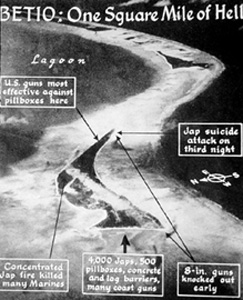 After briefly noting the similarity the blinking had to the sobriety tests my ex-wife used to give me with a pen light after returning home from my evening assignments, I barked into the newsroom, "Junko! Why are we out of toner again?"
After briefly noting the similarity the blinking had to the sobriety tests my ex-wife used to give me with a pen light after returning home from my evening assignments, I barked into the newsroom, "Junko! Why are we out of toner again?"
The junior reporter appeared at the copy room entrance in full splendor: summer's fashions on a spring doll. "Well," she began, "if you'd just subscribe to those girlie magazines rather than making copies of the janitor's issues, we wouldn't run out so quickly."
I started to mumble a defense but paused when I realized my ash might tumble.
"And also," she leaned over the machine, "this is a recession, in case you haven't heard. We must conserve supplies. You got the latest issue of Popeye on there or what?"
I removed my grit, dropped the ash into my temporary tray (empty coffee cup) waiting near the paper cutter, and turned towards her. Without looking down, I pulled the first few pages of my Kiribati report off the machine and thrust them into her hand. She reluctantly began reading.
With the world currently caught in the wake of "Pearl Harbor," the people of the tiny and isolated low-lying Pacific nation of Kiribati couldn't be bothered. For one, there are fish to catch, shells to collect, coconuts to pick, and pigs to raise. For another, there isn't a movie house in the entire country.
While such a scenario may seem like paradise, this collection of low-lying coral atolls is perhaps facing ecological disaster as global warming may eventually cause seas to swallow the islands whole. Destruction, however, is nothing new to some of the locals on Kiribati, formerly known as the Gilbert Islands, where six decades ago, Betio, the tip of the atoll Tarawa, was a World War II battlefield whose coral and sand landscape was turned into a charred crisp that resembled something like a lunar surface by Allied and Japanese forces.
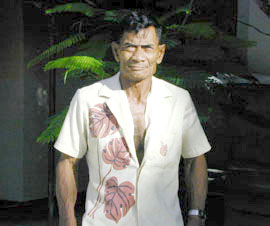 Betio was seen as a point of great strategic importance in the war in the Pacific. Japan originally claimed it from the British a few days following the attack on Pearl Harbor.
Betio was seen as a point of great strategic importance in the war in the Pacific. Japan originally claimed it from the British a few days following the attack on Pearl Harbor.
The Japanese arrived at Betio with 2,600 imperial marines in late 1942 and immediately began making preparations to defend their new airstrip. The island was converted into a fortress. Korean and local labor hacked tree trunks and assembled the logs into stockades. Concrete was poured for hundreds of pill boxes. Coastal guns, capable of firing 8-inch shells, were mounted along the beaches, which were further protected with coils of barbed wire, mines, and barricades of steel protruding from concrete mounts set in shallow water on both the lagoon and ocean sides. A single airstrip was cut into the center of the island, which is so narrow at certain points that the distance from lagoon to ocean could likely be reached with a 5-iron for most stretches.
"At that time, I wasn't mature enough to understand the situation," remembers Betero Tokaman, 66, a deeply tanned and heavily tattooed former seaman. "I had no idea why they were doing all the construction. I just followed my grandfather to the place of work everyday."
The Japanese worked night and day over the course of nine months. Betero adds, "[The Japanese were] not friendly in their way of supervising the people. It was very tough sometimes. Very rough. They whipped us if we didn't work properly."
Tekina Koakoa, 69, a part-time fisherman, his gray hair shortly cropped, concurs, "If you didn't listen to them, they'd whip you with a stick." Tekina estimates that more than a hundred Gilbertese in total were forced to work in shifts of maybe 30 at a time.
The battle raged over 4 days. Following the first shots from the Japanese coastal guns, American battleships and destroyers started their assault on the morning of November 20th. Bombers then pummeled Japanese positions from the air.
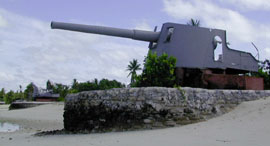 "During the fighting," Betero recalls, "we ran away to Teaoraereke [an island to the south]. I can remember the planes dropping bombs. We were very frightened. During the attack, it was focused on the Japanese bunkers and not on the Gilbertese. Maybe there was a communication with the Americans before the attack."
"During the fighting," Betero recalls, "we ran away to Teaoraereke [an island to the south]. I can remember the planes dropping bombs. We were very frightened. During the attack, it was focused on the Japanese bunkers and not on the Gilbertese. Maybe there was a communication with the Americans before the attack."
Tekina, who fled further south than Betero to the nearby island of Bikenibeu, says, "About twenty to thirty Gilbertese were on Betio during the fighting. I know of one who died. A piece of shrapnel from a bomb came up and struck him."
Betio forms the western end of Tarawa. After crossing the Nippon Causeway from Bairiki Island, one road loops around the perimeter of Betio's wedge-shaped land mass. At its most western point are the remains of two 8-inch coastal guns, some of the primary targets on that first day.
Soon after, Marines riding LVTs (Landing Vehicle Tracked) began the 10-mile charge towards the beach. Tarawa was seen as a testing lab for the vehicle, an amphibious craft possessing a rotating tread that was originally designed for traveling through swamps and marshes. That morning's low tide, as well, caused the low-draft LCVP (Landing Craft, Vehicle, Personnel) transport boats to be trapped on the reef off the lagoon. Weighed down with heavy equipment, some Marines drowned after attempting to wade ashore. Japanese machine-gun fire caught others. Casualties mounted. The lagoon ran red.
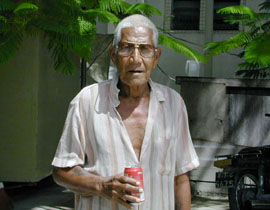 A small number of LVTs were able to land on the beach, but could not negotiate the coconut-trunk barricades. Sheets of bullets and tossed grenades rained down on the sand. But eventually a Japanese line of defense was broken by the end of that first day. At the Catholic Mission where Betero took shelter, he recalls seeing Betio being "lit by flames" during that first night.
A small number of LVTs were able to land on the beach, but could not negotiate the coconut-trunk barricades. Sheets of bullets and tossed grenades rained down on the sand. But eventually a Japanese line of defense was broken by the end of that first day. At the Catholic Mission where Betero took shelter, he recalls seeing Betio being "lit by flames" during that first night.
The next morning was a different story. A battalion of marines made a charge for the lagoon's beach at dawn. The losses were heavy (350 of 800 men) but boats were able to take advantage of the high tide and reach the western shores. Under tank and flamethrower support, the Japanese fortifications were slowly destroyed. The next day the land attack continued with the remaining fortifications being put out of commission. The Japanese made a final suicide charge from the east but were turned back. American victory was symbolically secured on November 23rd, when a Navy airplane was able to touch down on the airstrip. Of the 4,800 Japanese troops and construction workers, seventeen Japanese and 129 Koreans eventually surrendered. Casualties for the U.S. and British totalled 1,056 men.
"On Betio after the fighting, you couldn't see any coconut trees," recalls Betero upon his return. "You could count them - 4, 5, 6, 7, 8. But nothing else." Tekina slightly disputes this claim by saying, "Maybe 10 or 13 were left."
Even after the fighting stopped, Tekina remembers his return to Betio as one of caution. "After 6PM no one was allowed to go around because the Japanese at that time were still hiding and perhaps hungry. During the night it was thought that they would go out from their hiding place." Tekina says that this poicy continued for a few days after the fighting.
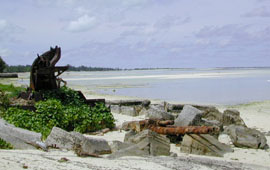 "After the fighting ended," says Betero, "some locals were recruited to clean up the area and build up the airfield. The American and British soldiers were very good people recalling American soldiers as being the first Americans he had ever met. "They gave us what we wanted and what we needed. They gave us cigarettes."
"After the fighting ended," says Betero, "some locals were recruited to clean up the area and build up the airfield. The American and British soldiers were very good people recalling American soldiers as being the first Americans he had ever met. "They gave us what we wanted and what we needed. They gave us cigarettes."
Andjobs, too. "We could work as a house boy or mess room staff," says Tekina. "They let us work and paid us."
Today, three Japanese guns rust away on the west and south shores, still mounted on concrete and pointed out to sea. While many I-Kiribati (locals) have adopted the concrete bunkers into their housing, seemingly ignoring their past use, will this nation of 100,000 be able to move forward as deftly should its next potential scourge - a rising sea - materialize in the future?
"I am not going to think about it," Tekina says. "I am just getting old. I listen to the news, but I think if there is a problem with sea-level rise, I would just run away."
Just like old times.
The World War II Series > Vanuatu > Betio Guns > John Swope > Kiribati

